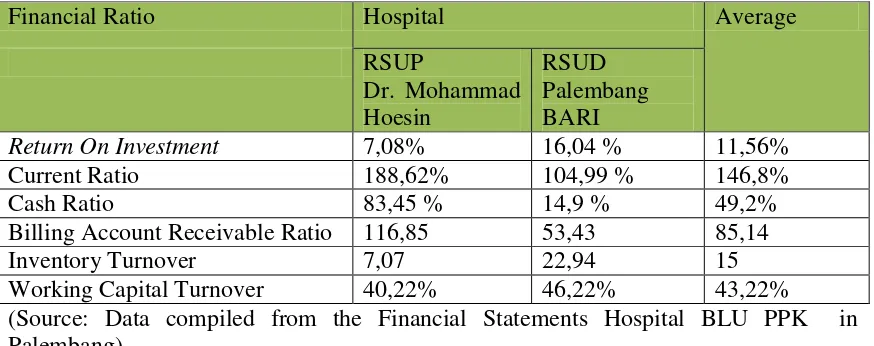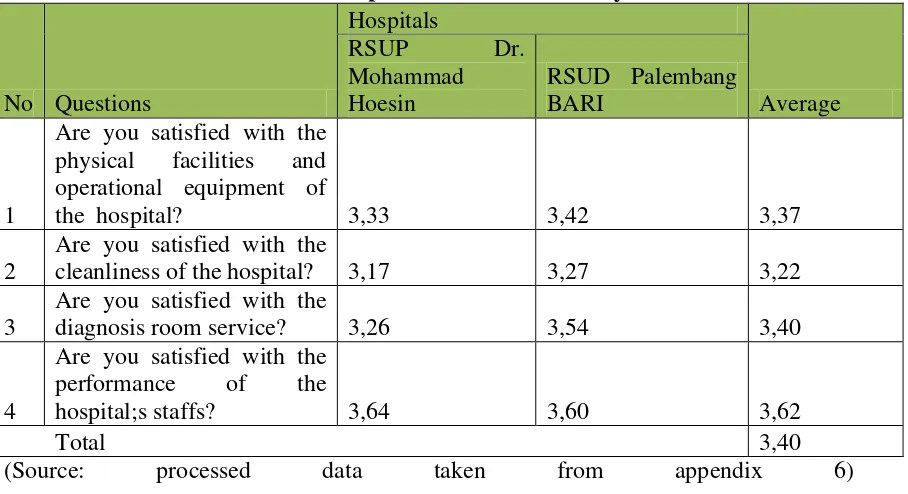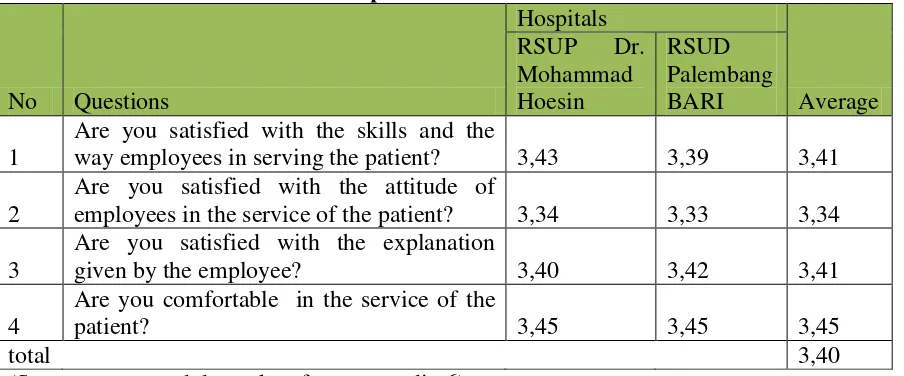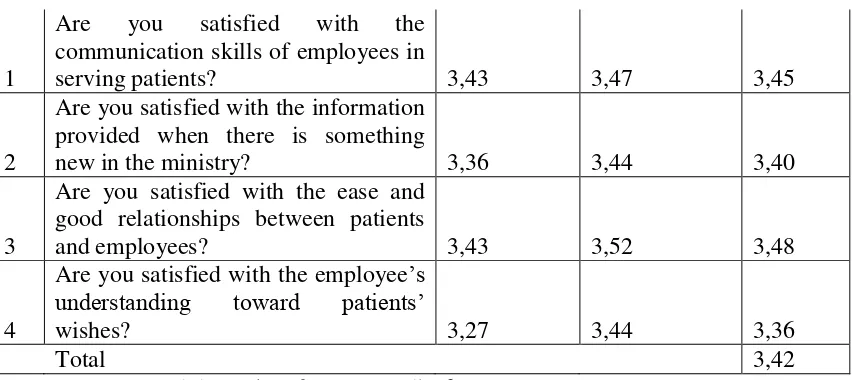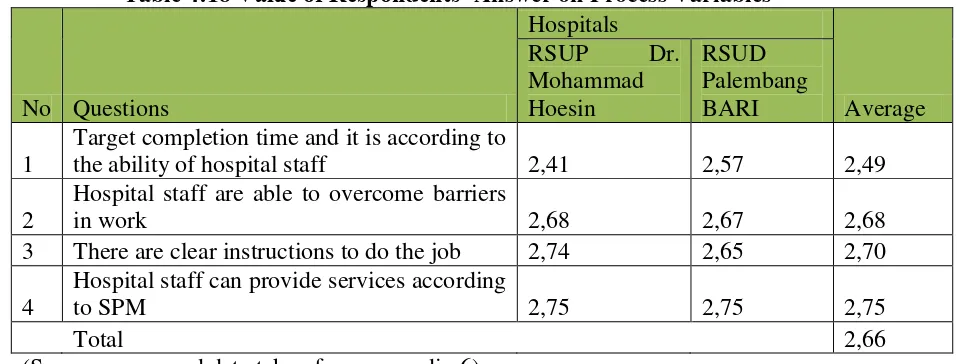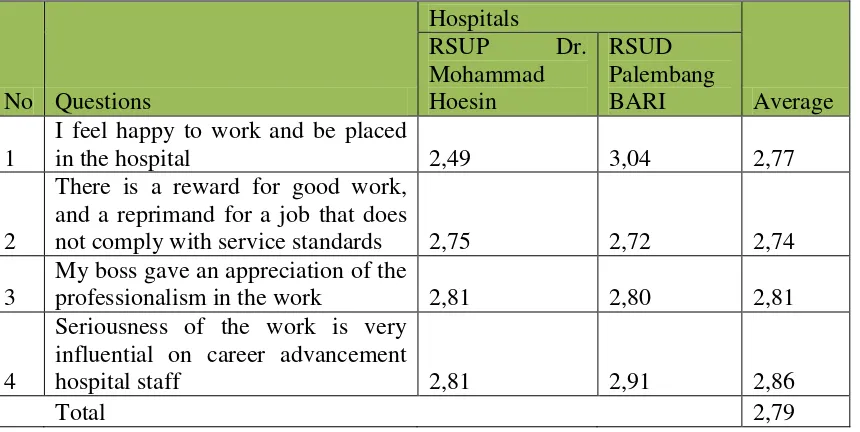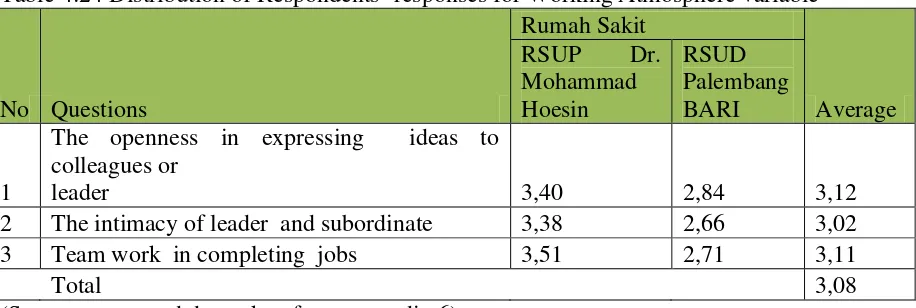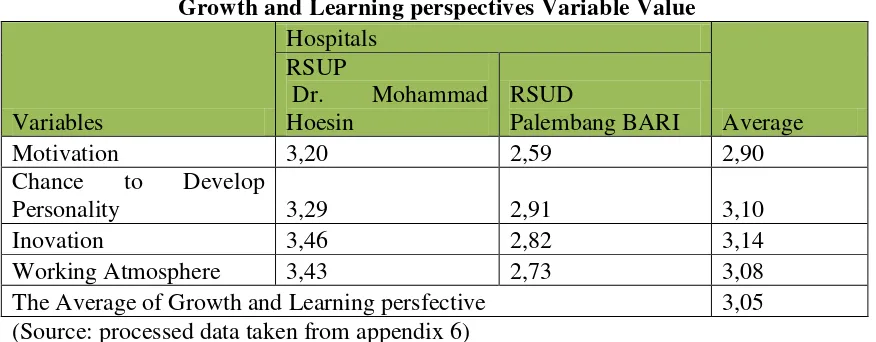BALANCED SCORECARD
PERSPECTIVE PERFORMANCE
ANALYSIS INPUBLIC SERVICE ENTERPRISES OF
GENERAL HOSPITALS IN PALEMBANG
Ika Sasti Ferina Universitas Sriwijaya
Didik Susetyo Universitas Sriwijaya
ABSTRACT
Public Service Enterprises (BLU) is an agency within the government that was formed to provide services to the community in the form of providing goods and/services sold without a priority to seek advantage and in conducting its activities it is based on principles of efficiency and productivity. As one health care provider, nowadays government hospitals have already implemented most of the Financial Management Pattern of the Public Service Board (PPK-BLU). The purpose of this study was to measure and evaluate the performance of the Public Service Board in Palembang City Hospital using the Balanced Scorecard approach. Financial perspective was measured by using the Return on Investment Ratio, Current Ratio, Cash Ratio, Collection Period, Inventory Turnover and Working Capital Turnover. While the perspective of customer satisfaction, internal business process perspective and learning growth were done by distributing 100 questionnaires to patients and hospital employees. The results of this study demonstrated the performance of the financial perspective on the General Services Agency Hospital in the city of Palembang was "Good", the perspective of customer satisfaction was "Good Enough" with the average value of 3, internal business process perspective was "Not Good" with a value average of 2, and learning growth perspective was "Good" with the average value of 3.
1. INRODUCTION
The new paradigm of state finance management in accordance to the legislation package in the financial sector includes the state Law no. 17 year 2003 about State Finance, Law No. 1 year 2004 about State Treasury, and Law No. 15 Year 2004 about the Audit of Management and Financial Responsibilities of the State. These laws contain at least the three principles of financial management of the country, namely: orientation on results, professionalism and accountability and transparency.
Paradigm mentioned above is intended to cut inefficiency. It is already a public perception that the government has been regarded as an inefficient and slow bureaucratic organization,. Yet in modern management, government must be professional, accountable and transparent. Transformation can be done in three ways, namely downsizing (rightsizing), corporatization and privatization (Tamin, 2011). Public Service Enterprise is one of the transformations in public health today.
hospital. Hospital's mission is inseparable from the social service mission, but it is in the hospital management that remains a conflict of interest from various parties.
Currently, the hospital should change its orientation-a combination of public service oriented and profit oriented. The most common change of government organization orientation in public service institutions happen to judicial reorganization and financial reorganization, which is implemented through the application of Public Service Enterprises (BLU) in some public service institutions. Based on Government Regulation (PP) No. 23 of 2005 about Financial Management of Public Service, BLU is non-profit governmental agency set up to provide services or goods and does activities based on the principles of efficiency and productivity.
In Article 1 paragraph 2 of PP No. 23 of 2005 about financial management of Public Service Enterprise, it is stated that the pattern of Public Service Enterprise Financial Management is a pattern of financial management that provides flexibility in the form of flexibility to implement business practices to improve health services to the community in order to advance the general welfare and intellectual life of the nation. The main concern of BLU as stated in article 2 Regulation No 23 of 2005, the implementation of regulation article No. 29 paragraph (7) of Law No 1 of 2004, is to improve the public service in order to advance the general welfare and intellectual life of the nation by providing flexibility in financial management and productivity based on economic principles and application of sounding business practice.
These changes also impact on the performance pattern, the pattern of financial management report of hospitals. General hospitals management will lead to independent and autonomous services. The hospital continues to be encouraged to make efforts to reform and improve performance in each unit. This is evidence in Central Java that the application of BLU concept has positive impact on the income of hospitals that were once under 100 billion but now it can reach over 120 billion (Mardiatmo, 2010). In addition to the improvement of financial performance, the most important thing is that hospitals are required to improve service performance. But in fact, there are many complaints in government hospitals, especially in terms of service and quality hospital facilities.
Based on the results of a survey conducted by the Indonesia Corruption Watch in the Year 2009 in Jabotabek, bad service hospital is particularly felt by the middle to lower class people. It is found that 28.4% of patients stated that hospital administration was complex, approximately 46.9% complained of long lines. The hospitalized patients
complained about the doctors’ low visit rate to patients, while 65.4% of hospitalized female patients complained about the attitude of nurses (Amri, 2010). This problem does not happen in Jakarta only, many complaints are also felt at one government hospital in Palembang (Kertaningtyas, 2011), especially medical services to patients who use Jamkesmas (Noerdin, 2011).
This phenomenon is contrary to the primary purpose of application of the BLU at the hospital, as expressed by the Minister of Health that the application of the BLU, which concerns that the hospital can improve the quality of health services for the community (Supari, 2006). For this great benefit, it is expected in year 2011 all hospitals in Indonesia have got the status of the General Service Enterprises (Supari, 2006).
such as the level of patient satisfaction, the ways of the hospitals in improving service and employee satisfaction levels of implemented hospital management system are needed. In consequences, the decision makers will get a comprehensive overview information of hospital performance. If we correlate it with the main purpose of BLU, the Balanced Scorecard is the most appropriate performance measurement tool.
Based on previous studies it can be concluded that the concept of the balanced scorecard can be applied to measure performance of public sector and to reinforce the correctness of the decision-making for public sector management. This study is the development and the integration of previous researches. The difference lies in the use of variable financial perspective-Return On Investment, Current Ratio, Cash Ratio, Billing Accounts Receivable, and Inventory Turnover Working Capital Turnover.. Based on the above description, the problem to be answered by this study is How Performance Measurement with the balanced scorecard approach (financial, customer, internal business processes, growth and learning) at the Public Service Hospital in the city of Palembang is.
2. LITERATURE REVIEW
Stakeholder theory is a theory which describes the corporate parties (stakeholders) that have the responsibilities (Freeman, 2001). The company must maintain relationships with its stakeholders to accommodate the desires and needs of its stakeholders, especially stakeholders who have the power to the availability of resources used for the operational activities of the company, such as labor, the market and etc. (Chariri and Ghozali, 2007).
According to Wheeler and Sinlanpaa in Daniri (2006) stakeholders are categorized into two categories based on the priority. For the Public Service Board, this Primary and Secondary Stakeholder can be regarded as primary stakeholders. Company in this case the hospital must maintain a good relationship as well as accommodate the desires and needs of public. As the stakeholders, the public can evaluate the performance of hospital services which will provide an opportunity or a treatment to the hospital itself, and the employees-primary stakeholders.
Performance measurement is defined as a process of assessment of the progress of work towards the goals and objectives that have been previously determined, including information on the efficiency, the use of resources in producing goods and services, quality of goods and services, comparison of the results of the activities with the target, and the effectiveness of actions in achieving the goal ( Robertson in Mahmoodi, 2010).
According to Mahmoodi (2010) there were six goals in the public sector performance measurement: (1) To determine the level organizational goals’ achievement (2) To provide a means for staff’s learning (3) To improve the performance of the next period (4) To provide a systematic consideration in decision-making and reward punishment (5) To motivate employees (6) To create public accountability.
Balanced Scorecard in the public sector has undergone a modification in which public sector organizations put the customer perspective as the top priority in running the organization, meaning that public sector organization's strategy will be aimed at improvement of public services. Each performance targets in the financial perspective, internal business and learning and growth will be directed at efforts to increase customer satisfaction.
Public Service Enterprises, based on Article 1 of Regulation No 23 of 2005 is within the government agency established to provide the public supply of goods / services sold for non profit priority and based on the principles of efficiency and productivity in doing activities.
The objective of the BLU according to Law No. 1 of 2004 is to improve services to the community in order to advance the general welfare and intellectual life of the nation. Efforts to improve the service according to Regulation No. 23 of 2005 section 2 is to provide flexibility in financial management and productivity based on economic principles, and application of sounding business practices.
Previous studies with the balanced scorecard method, among others, carried out by Andersen and Lawriew (2002), entitled Improving Public Sector Governance Better Strategic Management. The result of this study is balanced scorecard can be applied to measure performance of public sector or government sector in improving and strengthening performance measurement accuracy in decision making for public sector management.
Maskur (2004) measured the performance of the balanced scorecard approach in l Dr. Kariadi HospitaSemarang. This Study reviewed four aspects, namely the financial aspects (ROI, cash ratio, operating ratio, and sales growth), customers (customer satisfaction, customer retention and customer profitability), internal business processes (the ratio of outpatient and doctor number, ratio of outpatient and nurse number, ratio of emergency patient and doctor, ratio of emergency patient and nurse, the ratio of hospitalized patient and doctor, the ratio of hospitalized patients and nurses, Bed Occupancy Red (BOR), Average Length Of Stay and Bed Turn Over (BTO), and learning and growth ( employee loyalty, employee productivity, absenteeism and the ability of information systems). Results of measurements show that the overall performance of hospital Dr. Kariadi Semarang is pretty good, although the achievement of each perspective is not maximum.
Piani (2008) examined the performance measurement of DR.HM Rabain General Hospital Muara Enim in Financial and Non Financial Ratios in the year 2006-2008. Financial ratios used by her were ratio of capital structure, activity ratios and profitability ratios. While non-financial ratios used by her were Red Bed Occupancy (BOR), Turn Over Interval (TOI), Bed Turn Over (BTO), Average Length of Stay (ALOS), Gross Date Rate (GDR) and the Net Date Rate (NDR). Research results show that based on the ratio of financial and nonfinancial performance there was an increase in DR.HM. Rabain hospital Muara Enim in 2006-2008. Wirasata (2010) also conducted performance measurement Tg Uban Hospital using Balanced Scorecard method. Financial ratios method used by him was value for money (efficiency, effectiveness and economy), the solvency ratio and liquidity ratio. The results show that the overall performance assessment considered quite good, although not optimally.
Capital Turnover are used. As for the customer perspective, internal business process perspective, the perspective of growth and learning performance measurements conducted by distributing questionnaires directly to patients and hospital staff.
3. RESEARCH METHODOLOGY
The study is a qualitative descriptive study conducted at the Hospital General Services Enterprises (BLU) in Palembang. In order to give more focus limitation, the scope of this study is limited to discussion of a comprehensive performance review from the customer perspective, financial perspective, internal business process perspective, the perspective of growth and learning in the Public Service Hospital in Palembang.
In Palembang in 2011, Director General Pembinaan KDP-BLU, has set 4 (four)
hospital’s BLU-status. However, because of the financial perspective of performance measurement shown in the audited annual financial statements, then the object of this research is limited to Dr. M. Hoesin Hospital and Palembang BARI Hospital.
Population and Sample
The population in this study is Dr Dr. Mohammad Hoesin Palembang and BARI hospitals, while the samples used in this study were: 1) patients to measure the performance of the customer's perspective and 2) employees of hospitals to measure the performance of the internal business process perspective and the perspective of the growth / learning. The determination of the number of samples must be representative to the population of this study, in this case researchers used slovin formula in setting the number of samples with an error rate of 10%.
Researchers used a simple sampling techniques / proportional random sampling for customer satisfaction perspective by taking random samples from populations with / without regarding proficiency level of the population strata (Sugiyono, 2010). For the internal business perspective and the growth / learning, disproportionate stratified random sampling techniques were used because the population was stratified but less in proportion (Sugiono, 2010).
Types and Data Sources
This study uses primary data obtained directly from the source data, namely data from interviews with management / employees of hospitals, patients and the results of a questionnaire. In addition, it is also used secondary data obtained indirectly from the data source, namely from the 2010 financial statements, audited Dr. Mohammad Hoesin, Palembang BARI hospitals and strategic planning documents.
.
Data Collection Method
To collect primary and secondary data mentioned above, three data collection techniques, namely: interviews, questionnaires / questionnaires and observation were used (Sugiyono, 2010). In interviewing techniques, interviews were conducted in in-depth unstructured nature of the research subject directly to management / employees of hospitals and patients.
independent assessments can be maintained. The questionnaire used in this research was a questionnaire made by Wirasita (2010) which was modified by the researcher. The distribution of the questionnaire is done directly (the questionnaire is delivered directly to the respondent in question and taken back at the due time) in order to increase the rate of questionnaire return.
4. RESULTS AND DISCUSSION 4.1 Validity of Test Results
Validity of test results on customer satisfaction perspective consists of 17 items ( see Appendix ). Based on the results of the tests using SPSS 18, it can be concluded that question asked to the respondent has value of Pearson Correlation Sig (2-tailed) less than or equal to 0.05. Thus the questions used in this study are valid.
Validity of test results on internal business process perspective which consists of 12 questions used in this study can be seen in Appendix 3. Based on the results of tests using SPSS 18, it can be concluded that question asked the respondent has a value of Pearson Correlation Sig (2-tailed) less than or equal to 0.05. Thus the questions used in this study are valid.
Validity of test results for growth and learning perspective which consists of 14 questions used in this study can be seen in Appendix 3. Based on the results of tests using SPSS 18, it can be concluded that question asked the respondent has value of Pearson Correlation Sig (2-tailed) less than or equal to 0.05. Thus the questions used in this study are valid.
4.2 Reliabilty of Test Results
Reliability testing used in this research was Cronbach's coefficient alpha (Nunnally, 1978). If value of Cronbach's Alpha of the test results is close to 1, then instrument measured is reliable. Cronbach's Alpha value of 0.6 or more is considered sufficient as a measuring tool used in research (Nunnally, 1978).
Cronbach's Alpha value obtained by processing the data using SPSS version for the perspective of each variable is 0.929 for the perspective of customer satisfaction, 0.921 for the internal business perspective and 0.876 for growth and learning perspective. All variables have a value of more than 0.6 Alpha so it can be concluded that the variables in this study reliable.
4.3 Financial Perspective
the results of calculation of financial ratios that apply to the Hospital Financial Management Pattern of Public Service Board (PPK-BLU).
Table 4.5 Hospital PPK BLU Financial Ratio in Palembang
Financial Ratio Hospital Average
RSUP
Dr. Mohammad Hoesin
RSUD Palembang BARI
Return On Investment 7,08% 16,04 % 11,56%
Current Ratio 188,62% 104,99 % 146,8%
Cash Ratio 83,45 % 14,9 % 49,2%
Billing Account Receivable Ratio 116,85 53,43 85,14
Inventory Turnover 7,07 22,94 15
Working Capital Turnover 40,22% 46,22% 43,22%
(Source: Data compiled from the Financial Statements Hospital BLU PPK in Palembang)
Based on the calculation of financial ratios in Table 4.5 for hospitals that implement the General Service Enterprises in Palembang, the obtained Return On Investment is 11.56%. This ratio is a measurement of the effectiveness of the overall operations of a business. The smaller (lower) Return On Investment, the less the effectiveness (Kasmir, 2010). ROI with a value of 11.56% is generated from the investment value of the hospital for 11.56% of total investment. This value is considered quite good because the hospital is able to produce 11.56% per year due to the amount of investment issued by the company. However, this value can still be improved in line with the hospital performance improvement.
Current Ratio for the ability of hospitals to repay short-term obligation measurement is 146.8% . Kasmir (2010) states the higher the Current Ratio hospitals is, the more ability of the hospital to pay short-term obligations or debts due at the time billed as a whole. Based on the Current Ratio obtained, it can be concluded that short-term obligations of the Hospital General Services Enterprises in Palembang for 12 months period can be paid 146%. If the Current Ratio of the hospitals are 146.8%, it means current assets owned by hospitals are 1.468 times current liabilities, it is very good value because the hospital is considered able to pay its current liabilities.
Cash ratio is a measure to see how much cash available to pay debt. Cash ratio is achieved for General services agency of Hospital in the City is at 49.2%. If the value of 49.2% means the amount of cash available (either in the form of cash, savings account or other) debt of the hospital was 49.2%, or 0.49 times the debt.
Values obtained for the collection of accounts receivable amount to 85.14. The results of these calculations indicate how many days the average receivables to be collected during the period. Value of 85.14 indicates that the receivables in the average hospital can be collectible within a period of 85.14 days, and can be considered good.
Kasmir (2010) stated that a business can be said effective if it does not hold or store an excessive amount of preparation.
Working capital turnover ratio is one way to measure the effectiveness of working capital of business in one period. If the value of working capital turnover worth 43.22% means that the sale was worth 0.43 of the value of working capital. This condition is not good for General Services Agency of Hospital in the city of Palembang because the revenue is not maximized.
Under the guidance rating of hospital (LPSK, 2010) for the financial perspective the average pattern of hospital management to implement the General Services Agency in the city of Palembang, it is obtained a Good average value. The results of these performance measures are in line with the main aim of the Public Service Board that with the formation of BLU. Financial management can be more efficient and effective. It is Expected by changing the status of the hospital into the General Service Board can make efficient use of funds available (Wahid, 2006). Financial Management of Public Service Board is also meant to provide benefits to the hospital in improved performance and better financial management (Wahid, 2009).
4.4. Customer Satisfaction Perspective
In assessing the level of customer satisfaction on services provided Dr Dr. Mohammad Hoesin and BARI hospitals Palembang, questionnaires and interviews were used to 100 respondents from each hospital. With a population of 22 492 people in the department of Dr. Mohammad Hoesin (September 2011) and amounted to 5406 people in Palembang BARI hospitals (October 2011). Respondents are classified by level of education. Therefore, the method of data collection is by using a questionnaire. The level of education is assumed to be the benchmark for answering questions related to perceptions of service and understanding of the quality of care.
The results of the questionnaire filling customer satisfaction levels for each variable Service Quality will be explained as follows:
1). Physical form (tangibles)
Table 4.9 The Value of Respondents’ answer on Physical Variable
No Questions
cleanliness of the hospital? 3,17 3,27 3,22
From Table 4.9, it is known tthat the respondent's answer in the form of physical variables. From Table 4.9 above it can be seen the lowest average value of the item variables for hospital hygiene and the highest was 3.62 3.22 in the appearance and tidiness hospital staff. Dr Mohammad Hoesin hygiene variable has a value 3,17 lower than at BARI hospitals Palembang. From the observation results for the cleanliness of toilet facilities in DRMohammad Hoesin is still not maximum. There are indicators seen from some of the clogged toilet facilities and lack of clean water. However this is understandable, because the users of water facilities is general enough and either from the patient, family members, or visitors. While at the District Hospital in Palembang BARI the toliets are not eough. There are only three toilets for three floosr so that patients often wait in line.
2). Reliability
Table 4.10 The Value of Respondents Answer on Reliability Variable
No Questions
responsive service from the staff? 3,36 4,06 3,71
2
Are you satisfied with administrative
recording service from the hospital? 3,43 3,36 3,39
Jumlah 3,55
(Source: processed data taken from appendix 6)
From Table 4.10 it can be seen that the lowest average value of the variable item in the ability of hospital administration / record keeping that is equal to 3.39. In the department of Dr Mohammad Hoesin obtained value 3.43. While at Palembang BARI hospitals it was obtained a lower value of 3.36. From the results of direct observation and interviews with some respondents, it was found out that they complain of long queues for outpatient administration. In the department of Dr. Mohamaad Hoesin cause is due to the large number of visitors to Jamkesmas, Askin, and jamsoskes, The same thing also happened at Palembang BARI hospitals. In addition to the BARI hospitals, it is also caused by a lack of human resources and facilities and infrastructures at the service.
3). Responsiveness
Table 4.11 The Value of Respondents’ answer on Responsiveness Variable
No Questions
the patients’ complaints? 3,36 3,32 3,34
2
Are you satisfied with the quick response
3
Are you satisfied with information from the
staff/ 3,43 3,46 3,45
Total 3,38
(Source: processed data taken from appendix 6)
From Table 4.11 above, the lowest average value of variables contained in the item of giving a positive response to the complaints of patients that is equal to 3.34 and the highest average value of the variable item of information provision 3.45. The lowest value obtained in Palembang BARI hospitals of 3.32. From the results of interviews with the patient's response at both hospitals were found out that staffs were not responsive, and later in particular section III class (Service Askin, Jamsoskes, Jamkesmas). In the other class there were some who complained about the length of treatment from the doctor to patient complaints.
4). Assurance
Table 4.12 The Value of Respondents answer on Guarantee Variable
No Questions
way employees in serving the patient? 3,43 3,39 3,41
2
Are you satisfied with the attitude of
employees in the service of the patient? 3,34 3,33 3,34
3
(Source: processed data taken from appendix 6)
From Table 4.12 above, to the lowest value of the respondent's answer is the attitude of employees in the service of patients, 3.34. The lowest value obtained in Palembang BARI hospitals of 3.33. Interviews with respondents in the department of Dr. Mohammad Hoesin shows that in the hospitality employees in response to a question from patient are still lacking, and yet so insufficient the culture of smile and greet the patients and their families. But when seen from the respondent's answer to the perspective of overall customer satisfaction and is calculated by 3.43 Likert values obtained (Table 4.14) which means it is sufficient
5). Empathy
Table 4.13 The Value of Respondents’ Answer Empathy Variable
1
Are you satisfied with the communication skills of employees in
serving patients? 3,43 3,47 3,45
2
Are you satisfied with the information provided when there is something
new in the ministry? 3,36 3,44 3,40
3
Are you satisfied with the ease and good relationships between patients
and employees? 3,43 3,52 3,48
4
Are you satisfied with the employee’s
understanding toward patients’
wishes? 3,27 3,44 3,36
Total 3,42
(Source: processed data taken from appendix 6)
On the variables of empathy, the lowest average values contained in the employee understanding of the patient 3.36 (Table 4.13). Dr Mohammad Hoesin has lower scores than RS BARI Palembang that is equal to 3.27. Obviously this needs to get the attention of hospital management. Based on the results of research in Canada, it reveals that the officer who gave the attention to the patient, making repeated patient visits (Steward, 2001).
Overall customer satisfaction perspective the General Service agency (BLU) hospital in the city of Palembang in the average value of 3.43 which can be categorized as Good Enough (Table 4.14).
Table 4.14 Value of Customer Satisfaction Variables perspective BLU Hospital in Palembang
Variables
Hospitals
Average RSUP Dr. Mohammad
Hoesin RSUD Palembang BARI
Physical form 3.35 3.44 3.40
Reliability 3.39 3.71 3.55
Responsiveness 3.37 3.39 3.38
Assurance 3.40 3.39 3.40
Empathy 3.37 3.47 3.42
average value of variable perspectives Customer Satisfaction 3.43 (Source: processed data taken from appendix 6)
4.5 Internal Business Process Perspective
Internal business perspective performance appraisal was conducted by distributing questionnaires to 100 respondents from the 2513 permanent employees in Dr. Mohammad Hoesin and 100 respondents from 447 in Palembang BARI hospitals.
The summary of answers based on observations for each variable internal business perspective can be seen, as follows:
Table 4:17 The Value of Respondents’ Answer on Infrastructure Variables
Stationery equipment needed is available and in
good condition 3,08 2,72 2,90
2
inspection and repair of office inventory has
been done 2,65 2,74 2,70
3 Data and information obtained are complete 2,75 2,99 2,87
4
Computerization has been running well in supporting the effectiveness and efficiency of
work 3,90 3,10 3,50 supporting the effectiveness and efficiency. In the department of Dr. Mohammad Hoesin, It been has implemented a Management Information System for the accounting QPRO RS and RS SIM core to the pharmacy, patient administration inpatient, outpatient and mobilization of funds.
2). Process
Table 4:18 Value of Respondents’ Answer on Process Variables
No Questions
Target completion time and it is according to
the ability of hospital staff 2,41 2,57 2,49
Hospital staff can provide services according
to SPM 2,75 2,75 2,75
Total 2,66
(Source: processed data taken from appendix 6)
handling of patients has been set by default in accordance with the provisions of legislation as outlined in the Minimum Service Standards and has been applied in the treatment of patients. Item targets for completion time variables that do not correspond to the ability of hospital staff, based on the results of research on some of the department of Dr. Mohammad Hoesin obtained information, is largely due to the large number of patients that should be handled by employees, so job done sometimes does not match the expected target. Even at the Hospital Palembang BARI some workers complained about the lack of human resources.
3). Work satisfaction
Table 4:19 The Value of Respondents’ Answer on Job Satisfaction Variable
No Questions
not comply with service standards 2,75 2,72 2,74
3
My boss gave an appreciation of the
professionalism in the work 2,81 2,80 2,81
4
Seriousness of the work is very influential on career advancement
hospital staff 2,81 2,91 2,86
Total 2,79
(Source: processed data taken from appendix 6)
From the table, the results obtained the lowest average value of the variable item were rewards for good jobs and a reprimand for a job that does not comply with the standards of service for 2.74. The lowest value of 2.72 was at Palembang BARI hospitals. Based on interviews with several employees Palembang BARI hospitals and Dr. Mohammad Hoesin It was obtained information that the form of awards for employee performance is given by the hospital only once a year and the number is very limited. Assessment criteria for the best employees are also not clear, so it does not provide motivation for employees to compete in improving its performance. By using a Likert scale, the general level of work satisfaction of hospital staff obtained an average value of 2.79 with the criterion of Not Good.
Process 2,65 2,66 2,66
Work satisfaction 2,72 2,87 2,79
The mean value of the variable Internal Business Process
Perspective 2,81
(Source: processed data taken from appendix 6)
4.6. Learning and Growth Perspective 1). Motivation (reward and punishment)
Table 4:21. The Value of Respondents’ Answer on Motivation Variables
No Questions
The increase in allowance increases the
morale of employees 3,12 2,50 2,81
2
Promotion is running fine as required, giving rise to the motivation to work
more professionally 2,69 2,59 2,64
3
Enforcement of professional codes of
ethics have been implemented well 3,40 2,75 3,08
4 Attendance system running properly 3,41 2,33 2,87
5 Leaders motivate the work 3,28 2,69 2,99
6
Refreshing activity is done together to
reduce the stress in the works 3,35 2,72 3,04
Total 2,90
(Source: processed data taken from appendix 6)
Table 4:21 lowest average value of 2.64 found in the variable item promotion running fine as required, giving rise to the motivation to work more professional. Based on interviews with respondents in Palembang BARI hospitals, information is obtained that the promotion and positions are not given uniformly and transparently, and
Open opportunity for every hospital staff
to learn and continuing education 3,05 2,89 2,97
2
Leaders encourage employees to continue
learning and develop potential 3,42 2,95 3,19
order to improve knowledge and skills
Total 3,10
(Source: processed data taken from appendix 6)
From the table above, the lowest average values is open opportunity for every hospital staff to learn and continuing education, 2.97. The lowest value for Palembang BARI hospitals is 2.89 and Dr. Mohammad Hoesin is 3.05. Based on interviews with hospital management, it was found out that permission for continuing school is granted based on
hospital’s needs.
3). Innovation
Table 4:23 Distribution of Respondents’ Innovation Value Variable
No Questions
Employees are motivated to do innovation
in working 3,50 2,75 3,13
2
Leader gives appreciation to the positive
new ideas 3,43 2,88 3,16
Total 3,14
(Source: processed data taken from appendix 6)
In the table, the lowest average value of the items is Employees are motivated to do innovation in working for 3.13 and the highest value on the item variable of Leader gives appreciation to the positive new ideas for 3.16. Hospital obtained the lowest score of 2.75 Palembang Bari. Additional information obtained from interviews with employees revealed that communication between employees and leaders in every part of the meeting is not scheduled on a routine. These activities will be held if there are any problems, so the motivation for the future development is of only a handful.
4). Working Atmosphere
Table 4:24 Distribution of Respondents’ responses for Working Atmosphere variable
No Questions
In Table 4:24 The lowest average value of variables working atmosphere is in intimacy variable relationship between leaders and subordinates 3.02 with good category. Palembang BARI hospitals have the lowest value 2.66. Intimacy in relationships may be created by work activities outside of work hours to do a refresher with the family as family gathering, or other dissemination activities outside working hours. With a more intimate a sense of togetherness and motivation in the work relationship will be able to be created.
Table 4:25 BLU Hospital in Palembang Growth and Learning perspectives Variable Value
Variables
Hospitals
Average RSUP
Dr. Mohammad
Hoesin
RSUD
Palembang BARI
Motivation 3,20 2,59 2,90
Chance to Develop
Personality 3,29 2,91 3,10
Inovation 3,46 2,82 3,14
Working Atmosphere 3,43 2,73 3,08
The Average of Growth and Learning persfective 3,05
(Source: processed data taken from appendix 6)
5. CONCLUSIONS AND RECOMMENDATIONS 5.1 Conclusion
Based on research results described in the previous discussion it can be concluded that:
1. Financial perspective performance measurement service enterprises of general hospital in Palembang is Good. This is in line with the main aim of the Public Service Enterprises, namely the creation of more effective and efficient financial management.
2. Performance measurement of customer satisfaction perspective public service enterprises in Palembang City hospital reaches the value 3:43, it is included in Good Enough category. Performance and customer satisfaction are not yet optimal, it should be increased in the future. Some customer complaints that led to such dissatisfaction include the lack of cleanliness of toilets; queues are still long, hospitality of employees is still bad. This is indicated by the lack of employee performance quality. This phenomenon in not in line with the aim of the Public Service Enterprises that is to improve services to the community. 3. The obtained value of performance measurement and internal business process
4. The obtained value of Public Service Enterprises performance measurement perspective of growth and learning is 3.05, with the category of Good Enough. Unfair promotion, culture of seniority, regular meeting can be used as input to the management of the hospital so that the performance of this perspective can be better in the future.
5. 2. Suggestions
1. The management and employees of the hospital must improve hospital performance for better performance in the future.
2. Additional qualified human resources are needed to improve the public service. The qualified human resources will support better performance of an organization.
3. Motivation and reward of leadership is expected to make a reference for employees to be able to provide excellent service and delivering creative ideas in the creation of service to the community.
REFERENCES
Amri Bambang Afri. 2010. ICW Temukan 13 Rumah Sakit Negeri Nakal. http://nasional.vivanews.com/news/read/124539icw_temukan_13_rumah_sakit _negeri__nakal. Diunduh 10 Februari 2011.
Andersen, H.V. and Gavin Lawrie.2002. Improving Public Sector Governance though better Strategic Management. Berkshire. UK: 2GC Active Manajemen.
Adriansyah. RSUD H Boejasin resmi jadi BLUD. http://www.tanahlautkab.go.id/berita-utama/rsud-h-boejasin-resmi-menjadi blud.cfm. Diunduh 10 Maret 2011
AM, Vianey Norpatiwi. Aspek Value added Rumah Sakit Sebagai Badan LayananUmum.http://www.stieykpn.ac.id/images/artikel/Aspek%20Value%20 Added%20Rumah%20Sakit.pdf. Diunduh 11 Maret 2011
Devas. Briant. 1989. Keuangan Pemerintah Daerah Di Indonesia. Jakarta : UI (Press)
Freeman, R.E., dan J. McVea. 2001. A Stakeholder Approach to Strategic Management, http://papers.ssrn.com/sol3/papers.cfm?abstract_id=263511, SSRN. Diunduh 25 Mei 2011
Chairin. Ghozali. 2007. Teori Akuntansi. Badan Penerbit Universitas Diponegoro. Semarang
Husein, W Farid . 2007. Kinerja Rumah Sakit BLU Harus Memberi Pelayanan Terbaik. http://www.depkominfo.go.id/berita/berita-utama-berita/kinerja-rumah-sakit-blu-harus-memberi-pelayanan-terbaik.Diunduh 3 Maret 2011
Imelda. 2004. Implementasi Balanced Scorecard pada Organisasi Publik. Jurnal Akuntansi dan Keuangan Vol 6 November 2004, pp 106-122
Kaplan, Robert S. & Norton, David P. 2000. Penerjemah: Peter R Yosi Pasla. Balanced Scorecard : Menetapkan Strategi menjadi Aksi. Jakarta : Erlangga
Kertaningtyas.2011. Konfrensi Pers Untuk Herdian http://pulaukabal.wordpress.com /2011/01/21/konferensi-pers-untuk-herdian. Di unduh 17 Februari 2011
Kasmir. 2010. Analisis Laporan Keuangan. Jakarta : Rajawali Pers
LAN & BPKP. 2000. Modul Sosialisasi Sistem Akuntabilitas Kinerja Instansi Pemerintah. Jakarta : LAN
Lembaga Pengembangan Sumberdaya Kesehatan (LPSK). Pedoman Penilaian Tingkat Kesehatan Rumah Sakit.
Mardiatmo.2010. BLU RS: Pelayanan Cepat, Pendapatan Meningkat. http://dinkessulsel.go.id/new/index.php?option=com_content&task=view&id= 224&Itemid=1. Diunduh 10 Maret 2011
Mahsun, Mohammad. 2009. Pengukuran Kinerja Sektor Publik. Yogyakarta : BPFE
Maskur. 2004. Pengukuran Kinerja dengan Pendekatan Balanced Scorecard (Studi Kasus Pada Rumah Sakit Dr. Kariadi Semarang).Tesis-S2.Universitas Diponegoro. Tidak Dipublikasikan
Nunnally, I.C. 1978. Psycometric Theory. 2nd. Mc Graw-Hill. New York
Noerdin, Zulkarnain. 2011. Dua jam Nunggu Dokter Baru Datang. Sriwijaya Post, 6 September 2011. Palembang
Piani, Liska. 2008. Rasio Finansial dan Rasio Non Finansial Sebagai Dasar Pengukuran Kinerja Rumah Sakit Umum Daerah DR.H.M Rabain Muara Enim, Tesis. Pasca Sarjana Universitas Sriwijaya. Tidak Dipublikasikan
PP No 24 Tahun 2004. Tentang Standar Akuntansi Pemerintahan
PP No 23 Tahun 2005. Tentang Pengelolaan keuangan Badan Layanan Umum
PP No 58 Tahun 2005. Tentang Pengelolaan Keuangan Daerah
Peraturan Menteri Keuangan No 76/ PMK 05/ 2008 Tentang Pedoman Akuntansi dan Pelaporan Keuangan Badan Layanan Umum
Pratisto, Aris.2010. Statistik Menjadi Mudah Dengan SPSS 17. Jakarta: Kompas Gramedia
Prastiti, Sawitri Dwi, Sangadah Lailu. 2007. Analisis Kesesuaian Penyusunan dan Penggolongan Indikator Kinerja Berdasarkan Konsep Balanced Scorecard (Studi di Rumah Sakit Umum Ngudi Waluyo Wlingi). Jurnal Ilmu Administrasi, Volume No 3, Nomor 2
Robertson, Gordon . 2002. Riview Kinerja. Lokakarya Riview Kinerja.BPKP
RSUP Dr. Mohammad Hoesin Palembang. 2010. Laporan Tahunan Bagian SDM.
RSUP Dr. Mohammad Hoesin Palembang. 2010. Profil RSUP Dr. Mohammad Hoesin.
RSUP Dr. Mohammad Hoesin Palembang. 2010. Laporan Keuangan BLU RSUP Dr. Mohammad Hoesin Tahun 2010
RSUP Dr. Mohammad Hoesin Palembang.2010. Laporan Bagian Rekam Medik 2010
RSUD Palembang BARI. 2010. Profil RSUD Palembang BARI
RSUD Palembang BARI. 2010. Laporan Keuangan BLUD Palembang BARI Tahun 2010
RSUP Dr. Mohammad Hoesin Palembang.2010. Laporan Bagian Rekam Medik 2010
Sugiyono. 2010. Metode Penelitian Pendidikan : Pendekatan Kuantitatif, Kualitatif dan HRD. Bandung : Alfabeta
Supari. 2006. Menkes : Semua RSUD Diharapkan Menjadi BLU.
http://www.jurnalnet.com/konten.php?nama=Aktualita&id=464. Diakses 3 Maret 2011
Sukmalana, Soelaiman. 2007. Manajemen Kinerja. Jakarta : Intermedia Personalia Utama
Sie Infokum-Ditama Binbangkum, Rumah Sakit Pemerintah Daerah Sebagai Badan Layanan Umum, http://www.jdih.bpk.go.id/ informasi hukum /RSUD_BLU.pdf. unduh 5 Maret 2011
Suharmiati. Budiyanto,Didik. Analisis Faktor-Faktor yang Mempengaruhi Tingkat Kepuasan Responden Pengguna Rawat Jalan RS Pemerintah di Indonesia. Buletin Penelitian Sistem Kesehatan. Vol 10 No 2. April 2007 : 123-130
Steward. M, Fast. 2001. Low Income Consumers Perspective on Determinants of Health Services Use. The Canadian Health Servives Research Foundation. http:// www.csrsf.ca/home_e.php. Diunduh 12 November 2011
Thabrany, Hasbullah. Rumah Sakit Berbentuk BLU : Bentuk Paling Pas Dalam Koridor Hukum Saat ini http://staff.ui.ac.id/internal/140163956/material/ RumahSakitSebagaiBadan LayananUmum.pdf. Diunduh 3 Maret 2011
Tunggal, Amin Wijaya. 2009. Mengukur dan Mengelola Keberhasilan Usaha dengan Balanced Scorecard. Jakarta: Harvindo
Triton, 2006. SPSS 13. Terapan Riset Statistik Parameterik.Yogyakarta: Andi
Tamin, Faisal.Transformasi Budaya Kerja Aparatur Negara.
http://www.setdaprovkaltiminfo/wp-content/uploads/2011/05/perda-no 30.pdf. Diunduh 12 Mei 2011
Wahid, Umar. 2009. BLU Bukan Swastanisasi Rumah Sakit. http://www.dpr.go.id/id/berita/komisi9/0000/00/245/blu-bukan-swastanisasti-rumah-sakit.Diunduh 20 Maret 2011
Wirasata, Putu. 2010. Analisis Pengukuran Kinerja RSUD Tg.Uban Provinsi Kepulauan Riau dengan Metode Balanced Scorecard. Tesis-S2. Tidak dipublikasikan
Wexley,KN. Yukl,GA. 1998. Perilaku Organisasi dan Psikologi Personalia. Bina Aksara. Jakarta
Yunan, Rahma, Diana, Ceasar. 2003. Penerapan Balanced Scorecard Sebagai Tolak Ukut Kinerja Manajemen pada PT. Bank Tabungan Negara (Persero) Cabang Malang. Jurnal Akuntansi dan Keuangan Balance, Volume 2, Prodi Akuntansi. FE UMM. Malang
Zeithaml, Valerie A. A.Parasuraman, Leonard L. Berry.1996. Delivering Quality Service : Balancing Customer Perception and Expectation. New York : The Free Press
Quinlivan, D, 2000. ‘Rescalling the Balanced Scorecard for Local Government’,
